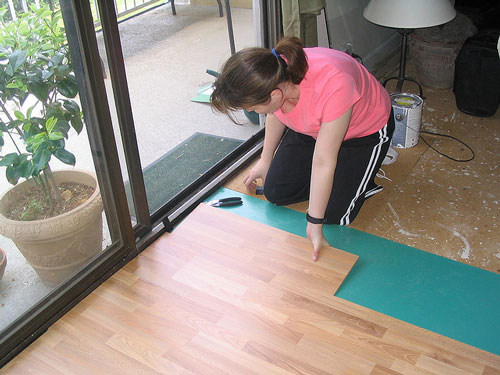A floating floor is just what the name says – a hardwood floor that ‘floats’ on top of your existing floor. The boards lock together like pieces of a jigsaw, without the use of glue, nails or staples. The advantage? The boards can be laid fast over nearly any material and you get a great looking floor ready for furniture in just a day.
There are lots of floating floor materials available today, with a huge choice of colour, width and grain. If it is real wood you want, you can opt for engineered flooring, a ‘sandwich’ of wood veneer glued to thin layers of plywood that looks just like solid wood.
Preparation is key
Once you have chosen what you want for your home – either engineered wood, timber, laminate or even bamboo flooring – it should be relatively easy to get started with the installation. And as with most things in life, the secret lies in the preparation!
Laying down the planks
Before you can start to lay down the planks, you need to measure the floor and prepare it to make sure it’s level. If you have a concrete floor, then cover it with a wood subfloor before you install the floating floor. If you’re working with a floor in an existing house, then it’s a good idea to remove the skirting boards before installing the new floor. Now that you’re ready …
- Roll out the manufacturer’s recommended underlay over the floor. Seal the seams with duct tape, making sure they don’t show.
- Choose which way the wood planks will lay. Parallel with the longest wall will look better.
- Place a spacer against the wall that is furthest from the door. Lay the first piece of flooring with the groove side against the wall. Make sure it fits against the spacer. Place the next piece end to end. It is important to have spacers around walls so that the floor will have enough room to expand.
- Lock two pieces of wood floor together. You can use a rubber mallet or wooden block to knock them together. Keep going with this process on the floor along the wall. Use a jigsaw to cut the wood as needed.
- Cut the last piece in the row so it will fit, leaving a small gap between it and any walls, again to allow for expansion of the wood.
- Place the next row. Make sure you stagger the joints so they overlap.
- Continue to stagger each new row until you have covered the whole floor with the square edged flooring.
- When you’re finished, remove all the spacers from the edges of the room and if you removed any skirting boards at the beginning, then replace them now.

Making it easy
Visit our showroom and speak to one of our sales specialists; they can help you find the flooring you’re looking for. We have a large range of floating timber flooring, and we offer a free measure and quote service. If you choose not to fit the floor yourself, our specialist fitters can do it for you, and if timber is your choice, you could have your new floor within the week and installed within a day thereafter. For even better deals on floating floors, try our Timber and Building Materials Auction.
Whatever you have in mind, carpet or timber, you can get a great deal at Fowles.
